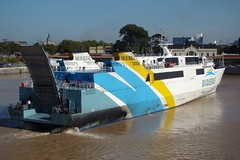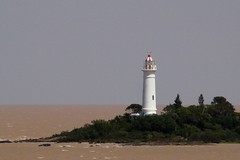
People waiting to board, Buquebús terminal in Puerto Madero, Buenos Aires

A boat of the Buquebús fleet, similar to ours

Marisa before the immensity of the Río de la Plata

The lighthouse of Colonia del Sacramento, as we came close
That said, I begin my tale, and I have to go back a little. My original idea was going to Uruguay via the most direct route for us, by land through Entre Ríos and from there to Paysandú or Fray Bentos. I would've liked to check out Gualeguaychú, which I saw years ago for a few hours, and Fray Bentos, with its (in)famous pulp mill. Fray Bentos is also where Borges chose to locate the story of Ireneo Funes, "the Memorious". But the news about road and bridge blocks by the Gualeguaychú Environmental Assembly were disquieting. It wasn't in our plan to begin our vacations stuck in the frontier.
Marisa then came up with the idea, which I seconded immediately, of going the other way, which was longer and more expensive but nicer and safer. We researched it a bit and finally booked passages on the Eladia Isabel, a boat of the Buquebús company, to go from Buenos Aires to Colonia del Sacramento across the Río de la Plata.
The trip to Retiro Station (BA) took us about four hours. We arrived at the hypertrophic capital of our country about three hours after leaving Rosario, and from Greater Buenos Aires to Retiro we spent some 45 minutes. Then we had to wait half and hour to enter the huge bus terminal, located wall-to-wall to a huge villa miseria, full of peddlers of dubious merchandise, its tarmac cracked or lost to negligence and time. How a capital which prizes itself on being the Paris of the South has a bus terminal that is so unnecessarily complicated to get into or out of, so ill-placed within its urban environment, and so filthy, escapes my comprehension.
We got off the bus, grabbed our stuff to guard it against unseen thieves, hailed a taxi, and were left on the Buquebús terminal in Puerto Madero, suddenly transported to another world, similar to a squeaky clean and very congested airport. We went through the embarkment paperwork, had coffee, and then boarded. The boat moved away from the coast slowly, and as we went far into the Río de la Plata I could see why Juan Díaz de Solís, the first European who found it and surveyed it, called it "Mar Dulce", that is, the Sweet Sea. It was an infinite expanse of earthen-brown water, with a few boats at the limit of one's vision looking like a gray cardboard figurine. Thus three hours passed, until we saw a few green islets and finally the white lighthouse of old Colonia.
To be continued...













No comments:
Post a Comment
Note: Only a member of this blog may post a comment.